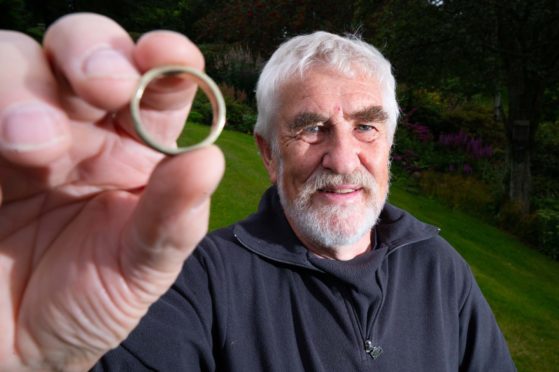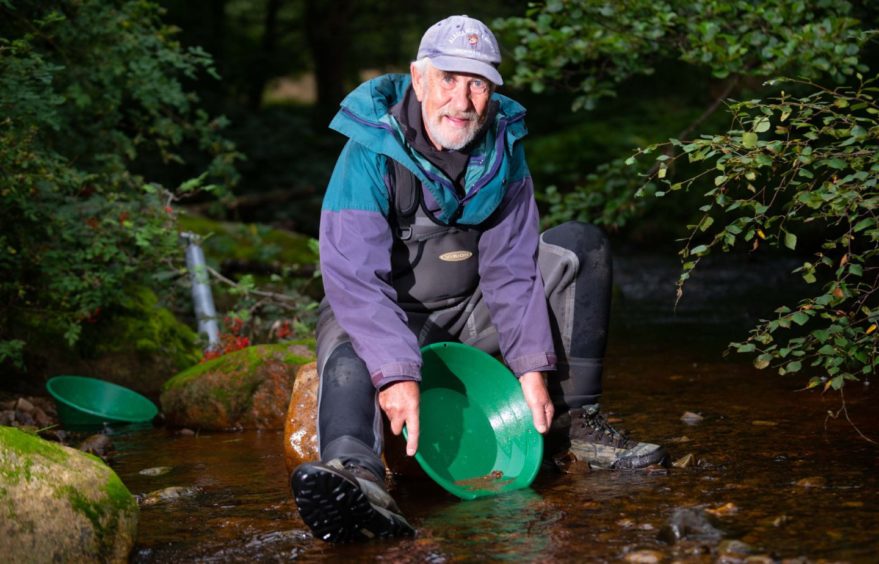Not many women would wait 40 years for their husband to fulfil a promise.
But Alan Souter vowed to make wife Colinne a ring from the gold he found while panning in Scotland – and it took him four decades to part with his treasure.
The 78-year-old began his hunt for the precious metal more than half a century ago, after starting off with a frying pan during his years as a geology student.
It was back then he promised his childhood sweetheart he would make her a ring with any gold he unearthed.
The keen prospector has since struck it lucky in more than 70 Scottish burns, often using homemade gadgets to extract the goods from the ground.
But Mr Souter, from Aberlour, said: “It took 40 years to get round to parting with the gold to be melted down.
“She said it was a long wait. But I prefer to see it in its raw state rather than it being turned into jewellery.
“When you see a little bit under the microscope, that’s how I like it. You’re the first person to have seen it when you see it in the pan. Until then, it’s been hidden away for hundreds of millions of years.”
Treasured ring nearly lost – in tomato plant
When Mr Souter handed hundreds of fragments from his vast collection to a goldsmith they were cast into two rings – the first 18ct and the other 14ct.
It takes around five grams of gold – the equivalent weight of one and a quarter teaspoons of sugar – to produce a ring.
Some of the flakes were so tiny, one of the rings was made from a combination of pieces found in 50 different burns across Scotland.
Mrs Souter, also 78, treasured the rings, although is no longer able to wear them due to her arthritic joints.
They are now stored away safely – after she nearly lost one for good.
Retired geography teacher Mr Souter said: “The ring fell off with another ring so I went out with a metal detector and found one in the compost bin, but couldn’t find the other.
“Then she was picking tomatoes in the greenhouse and there was the Scottish gold ring lying at the base of a tomato plant.”
The rings are now stored in a secure location along with his dozens of vials containing specks of gold and each labelled with the place they were found.
Teacher enjoys ‘buzz’ of the find
Mr Souter’s gold panning exploits have taken him to Alaska, New Zealand and a former gold mining community in Colorado.
Using the gold found overseas, Mr Souter also had a brooch, worth around £700, produced, and he presented it to daughter Fiona, 56, at the weekend to celebrate her being ordained as a priest.
He said: “It’s a unique brooch with half an ounce of gold in it, so it’s quite a heavy thing. It’s made from Scottish, Colorado, Alaskan and New Zealand gold. She’s delighted.”
Until recently, his wife, who he first met at school, joined him in his quest to find gold and the couple would work the rivers and burns together.
But he stressed the monetary value was never of interest to him and even after more than 50 years of panning he still “gets a buzz” when he finds even a microscopic flake.
“For me, it’s a good day out,” Mr Souter said. “Some [people] go to places where they know there is gold. I like to go where I think there might be gold.”
Hopes that hobby will have scientific value
Mr Souter hopes in the future his collection can be split between his two daughters and the Hunterian Museum in Glasgow, to help geologists identify how gold was formed in different parts of the country.
He added: “I’m not concerned with the money, just the good fun of looking for it. Hopefully it could be of some scientific value for an academic because gold is formed in a variety of ways.”
Mr Souter has now written a book about the trials and tribulations of being a gold panner, collating stories from various prospectors to keep their tales alive for future generations.
It tells how even the most experienced of prospects have lost their gold which has been blown away in the wind, lost in grass or even lapped up by a passing dog.

